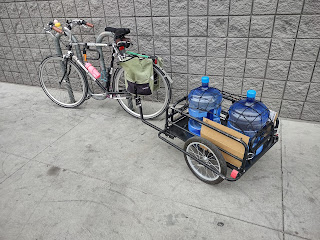The RTC does a great job building Rapids and a terrible job marketing them
Title basically. If you've visited Las Vegas, you probably know about the Deuce, the charming double-deckers that slowly wend their way from casino to casino along the Strip, and you might know about the SDX, which does what the Deuce does but faster (and in its own lane-- after it leaves the area with the heaviest traffic congestion). I strongly doubt you know about the Boulder Highway Express and Sahara Express, two rapid routes with signal priority, level boarding, and dedicated lanes, and I guarantee you don't know that similar features are present on routes 202 Flamingo and 113 N. Vegas as well. Huge swathes of the Las Vegas Valley are served by frequent, reliable busways, but it's hard to know that without actually riding the system.
As the ever-excellent Human Transit points out, right-of-way and stop spacing are the two most important factors for reliable transit. Five routes in the Las Vegas Valley have Class B rights-of-way, dedicated lanes just for buses and "rapid" stop spacing of at least 1/3 of a mile. This means that, if you use one of these lines, you can get across town in significantly less time than if you were to ride, say, my own dear 206 Charleston, which runs frequently but in mixed traffic. But this crucial distinction is masked from riders in basically all of the information published by RTC.
First of all, while I really, really love the new frequency-based system maps, they don't indicate the presence of dedicated lanes at all. The 206 Charleston looks just like the Sahara Express, even though the latter can be quite a lot faster. (They also don't indicate overnight service, but that's another post.)
Second, though, RTC's confusing route numbering practices fail to differentiate between very different types of service. Since rolling out the "ACE" brand on their buses, the RTC has conflated infrequent freeway commuter lines with frequent urban rapids. The former ACE Gold and Green lines are now the Strip-Downtown Express (SDX) and Boulder Highway Express (BHX), rapid buses with 15-minute frequencies, but the former ACExpress is now the Centennial Express (CX), a commuter express line with hourly frequencies and no stops between a distant suburban park-and-ride and downtown. Even before the ridiculous 2010 lawsuit, this was problematic. Now, with the addition of the Downtown-VA Hospital Express (DVX), the Henderson-Downtown Express (HDX), and the Westcliff-Airport Express (WAX), the confusion is growing.
Even worse, though, is the presence of other routes that have express features but aren't even branded as expresses. Route 113 took over the infrastructure of the former MAX line along North Las Vegas Blvd., and Route 202 has been receiving incremental upgrades as part of the BRT system's expansion. Unless you take the bus, you wouldn't know that.
Not only is this marketing failure a problem for present-day riders, who would benefit from understanding which buses are faster and more reliable, but it's a problem for RTC in attracting future riders. Highlighting Las Vegas' impressive busway network-- really, I don't know of any other mid-sized US city that has given so much street space to buses-- would encourage people to ride it, as busways are quicker and more reliable. Knowing that you could avoid being stuck in rush hour traffic is a significant incentive to switch to transit.
As the ever-excellent Human Transit points out, right-of-way and stop spacing are the two most important factors for reliable transit. Five routes in the Las Vegas Valley have Class B rights-of-way, dedicated lanes just for buses and "rapid" stop spacing of at least 1/3 of a mile. This means that, if you use one of these lines, you can get across town in significantly less time than if you were to ride, say, my own dear 206 Charleston, which runs frequently but in mixed traffic. But this crucial distinction is masked from riders in basically all of the information published by RTC.
First of all, while I really, really love the new frequency-based system maps, they don't indicate the presence of dedicated lanes at all. The 206 Charleston looks just like the Sahara Express, even though the latter can be quite a lot faster. (They also don't indicate overnight service, but that's another post.)
Second, though, RTC's confusing route numbering practices fail to differentiate between very different types of service. Since rolling out the "ACE" brand on their buses, the RTC has conflated infrequent freeway commuter lines with frequent urban rapids. The former ACE Gold and Green lines are now the Strip-Downtown Express (SDX) and Boulder Highway Express (BHX), rapid buses with 15-minute frequencies, but the former ACExpress is now the Centennial Express (CX), a commuter express line with hourly frequencies and no stops between a distant suburban park-and-ride and downtown. Even before the ridiculous 2010 lawsuit, this was problematic. Now, with the addition of the Downtown-VA Hospital Express (DVX), the Henderson-Downtown Express (HDX), and the Westcliff-Airport Express (WAX), the confusion is growing.
Even worse, though, is the presence of other routes that have express features but aren't even branded as expresses. Route 113 took over the infrastructure of the former MAX line along North Las Vegas Blvd., and Route 202 has been receiving incremental upgrades as part of the BRT system's expansion. Unless you take the bus, you wouldn't know that.
Not only is this marketing failure a problem for present-day riders, who would benefit from understanding which buses are faster and more reliable, but it's a problem for RTC in attracting future riders. Highlighting Las Vegas' impressive busway network-- really, I don't know of any other mid-sized US city that has given so much street space to buses-- would encourage people to ride it, as busways are quicker and more reliable. Knowing that you could avoid being stuck in rush hour traffic is a significant incentive to switch to transit.
.jpeg)

Comments
Post a Comment